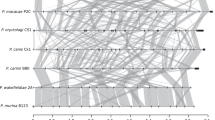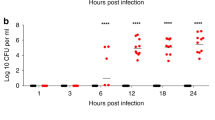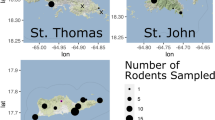Abstract
This review is an update on some of the remarkable advances that have led to greater understanding of Pneumocystis, an important group of rodent pathogens. The author outlines the life cycle of these pulmonic fungi, their taxonomic position, and their nomenclature. He discusses how infections begin and spread in laboratory rodent colonies, and how those infections are inadvertently maintained in barriered breeding colonies. He also addresses the diagnosis of Pneumocystis infection and provides suggestions for the establishment of Pneumocystis-free animal colonies.
This is a preview of subscription content, access via your institution
Access options
Subscribe to this journal
We are sorry, but there is no personal subscription option available for your country.
Buy this article
- Purchase on Springer Link
- Instant access to full article PDF
Prices may be subject to local taxes which are calculated during checkout
Similar content being viewed by others
References
Frenkel, J.K., Good, J.T. & Schultz, J.A. Latent pneumocystis infection of rats, relapse, and chemotherapy. Lab. Invest. 15(10), 1553–1557 (1966).
Percy, D.H. & Barthold, S.W. Pathology of Laboratory Rats and Mice 71–74, 144–145 (Iowa State University Press, Ames, IA, 2001).
Hughes, W.T. Animal models for Pneumocystis carinii pneumonia. J. Protozool. 36(1), 41–45 (1989).
Walzer, P.D. Overview of animal models of Pneumocystis carinii pneumonia. J. Protozool. 38(6), 1225–1235 (1991).
Soulez, B. et al. The young rabbit: a nonimmunosuppressed model for Pneumocystis carinii pneumonia. J. Infect. Dis. 160(2), 355–356 (1989).
Chagas, C. Nova tripanosomiaze humana. Mem. Istit. Oswaldo Cruz. 1, 159–218 (1909).
Chagas, C. Nova entidade morbider do homen. Mem. Inst. Oswaldo Cruz. 3, 219–275 (1911).
Delanoe, P. & Delanoe, M. Sur les rapports des kystes des carinii du poumon des rats avec le Trypanosoma lewisi. C.R. Acad-Sci (Paris). 155, 658–660 (1912).
Porter, A. The occurrence of Pneumocystis carinii in mice in England. Parasitol. 8, 255–259 (1915–16).
Walkeden, P.J. A rapid method for fungi and Pneumocystis carinii. Histo-Logic 20(4), 188–192 (1990).
Edman, J.D. et al. Ribosomal RNA sequence shows Pneumocystis carinii to be a member of the fungi. Nature 334(6182), 519–522 (1988).
Cushion, M.T., Kaselis, M., Stringer, S.L. & Stringer, J.R. Genetic stability and diversity of Pneumocystis carinii infecting rat colonies. Infect. Immun. 61(11), 4801–4813 (1993).
Stringer, J.R., Erdman, J.C., Cushion, M.T., Richards, F.F. & Watanabe, J. The fungal nature of Pneumocystis. J. Med. Vet. Mycol. 1 (Suppl), 271–278 (1992).
Stringer, J.R. The identity of Pneumocystis carinii: not a single protozoan, but a diverse group of exotic fungi. Infect. Agents Dis. 2(3), 109–117 (1993).
Stringer, J.R. Pneumocystis. Int. J. Med. Microbiol. 292(5–6), 391–404 (2002).
Sundberg, J.P., Burnstien, T., Schultz, L.D. & Bedigian, H. Identification of Pneumocystis carinii in immunodeficient mice. Lab. Anim. Sci. 39(3), 213–218 (1989).
Thomson, R.B. Jr., Smith, T.F. & Wilson, W.R. Comparison of two methods used to prepare smears of mouse lung tissue for detection of Pneumocystis carinii. J. Clin. Microbiol. 16(2), 303–306 (1982).
Dei-Cas, E., Brun-Pascaud, M., Bille-Hansen, V., Allaert, A. & Aliouat, E.M. Animal models of pneumocystosis. FEMS Immunol. Med. Microbiol. 22(1–2), 163–168 (1998).
Cushion, M.T., Ruffolo, J.J. & Walzer, P. Analysis of the developmental stages of Pneumocystis carinii in vitro. Lab. Invest. 58(3), 324–331 (1988).
Cushion, M.T. in Manual of Clinical Microbiology (eds. Murray, P.R., Baron, E.J., Jorgensen, J.H., Pfaller, M.A. & Yolken, R.H.) 1712–1725 (ASM Press, Washington, DC, 2003).
Cushion, M.T. & Walzer, P.D. Growth and serial passage of Pneumocystis carinii in the A549 cell line. Infect. Immun. 44(2), 245–251 (1984).
Cushion, M.T. & Walzer, P.D. Cultivation of Pneumocystis carinii in lung-derived cell lines. J. Infect. Dis. 149(4), 644 (1984).
Cushion, M.T. & Ebbets, D. Growth and metabolism of Pneumocystis carinii in axenic culture. J. Clin. Microbiol. 28(6), 1385–1394 (1990).
Aliouat, E.M., Dei-Cas, E., Billaut, P., Dujardin, L. & Camus, D. Pneumocystis carinii organisms from in vitro culture are highly infectious to the nude rat. Parasitol. Res. 81(1), 82–85 (1995).
Atzori, C. et al. Current in vitro culture systems for Pneumocystis. FEMS Immunol. Med. Microbiol. 22(1–2), 169–172 (1998).
Reddy, L.F. & Zammit, C. Proliferation patterns of latent Pneumocystis carinii in rat organs during progressive stages of immunosuppression. J. Protozool. 38(6), 43S–47S (1991).
Schluger, N. et al. Detection of Pneumocystis carinii in serum of AIDS patients with Pneumocystis pneumonia by the polymerase chain reaction. J. Protozool. 38(6), 123S–125S (1991).
Chary-Reddy, S. & Graves, D.C. Identification of extrapulmonary Pneumocystis carinii in immunocompromised rats by PCR. J. Clin. Microbiol. 34(7), 1660–1665 (1996).
Rabodonirina, M. et al. Detection of Pneumocystis carinii DNA by PCR amplification in various rat organs in experimental pneumocystosis. J. Med. Microbiol. 46(8), 665–668 (1997).
Wakefield, A.E. Genetic heterogeneity in Pneumocystis carinii: an introduction. FEMS. Immunol. Med. Microbiol. 22(1–2), 5–13 (1998).
Frenkel, J.K. Pneumocystis jiroveci n. sp. from man: morphology, physiology, and immunology in relation to pathology. Natl. Cancer Inst. Monogr. 43, 13–30 (1976).
Stringer, J.R. et al. Molecular genetic distinction of Pneumocystis carinii from rats and humans. J. Eukaryot. Microbiol. 40(6), 733–741 (1993).
Wakefield, A.E., Banerji, S., Pixley, F.J. & Hopkin, J.M. Molecular probes for the detection of Pneumocystis carinii. Trans. R. Soc. Trop. Med. Hyg. 84 (Suppl 1), 17–18 (1990).
Durand-Joly, I. et al. Pneumocystis carinii f. sp. hominis is not infectious for SCID mice. J. Clin. Microbiol. 40(5), 1862–1865 (2002).
Shah, J.S., Pieciak, W., Liu, J., Buharin, A. & Lane, D.J. Diversity of host species and strains of Pneumocystis carinii is based on rRNA sequences. Clin. Diagn. Lab. Immunol. 3(1), 119–127 (1996).
Stringer, J.R., Cushion, M.T. & Wakefield, A.E. New nomenclature for the genus Pneumocystis. J. Eukaryot. Microbiol. Suppl, 184S–189S (2001).
Gigliotti, F., Harmsen, A.G., Haidaris, C.G. & Haidaris, P.J. Pneumocystis carinii is not universally transmissible between mammalian species. Infect. Immun. 61(7), 2886–2890 (1993).
Aliouat, E.M. et al. Pneumocystis cross infection experiments using SCID mice and nude rats as recipient host showed strong host species specificity. J. Eukaryotic Microbiol. 41(5), 715S (1994).
Cushion, M.T. Taxonomy, genetic organization, and life cycle of Pneumocystis carinii. Semin. Respir. Infect. 13(4), 304–312 (1998).
Cushion, M.T., Keely, S. & Stringer, J.R. Molecular and phenotypic description of Pneumocystis wakefieldiae sp. nov., a new species in rats. Mycologia 96(3), 429–438 (2004).
Palmer, R.J., Cushion, M.T. & Wakefield, A.E. Discrimination of rat-derived Pneumocystis carinii f. sp. carinii and Pneumocystis carinii f. sp. ratti using the polymerase chain reaction. Mol. Cell Probes 13(2), 147–155 (1999).
Cushion, M.T. et al. Evidence for two genetic variants of Pneumocystis carinii coinfecting laboratory rats. J. Clin. Microbiol. 31(5), 1217–1223 (1993).
Vasquez, J., Smulian, A.J., Linke, J. & Cushion, M.T. Antigenic differences associated with genetically distinct Pneumocystis carinii from rats. Infect. Immun. 64(1), 290–297 (1996).
Palmer, R.J., Settnes, O.P., Lodal, J. & Wakefield, A.E. Population structure of rat-derived Pneumocystis carinii in Danish wild rats. Appl. Environ. Microbiol. 66(11), 4954–4961 (2000).
Schaffzin, J.K., Garbe, R.R. & Stringer, J.R. Major surface glycoprotein genes from Pneumocystis carinii f. sp. ratti. Fungal Genet. Biol. 28(3), 214–226 (1999).
Nahimana, A., Cushion, M.T., Blanc, D.S. & Hauser, P.M. Rapid PCR-single-strand conformation polymorphism method to differentiate and estimate relative abundance of Pneumocystis carinii special forms infecting rats. J. Clin. Microbiol. 39(12), 4563–4565 (2001).
Cushion, M.T. Manual of Clinical Microbiology (eds. Murray, P.R., Baron, E.J., Jorgensen, J.H., Pfaller, M.A. & Yolken, R.H.) 1712–1725 (ASM Press, Washington, DC, 2003).
Icenhour, C.R., Rebholz, S.L., Collins, M.S. & Cushion, M.T. Widespread occurrence of Pneumocystis carinii in commercial rat colonies detected using targeted PCR and oral swabs. J. Clin. Microbiol. 39(10), 3437–3441 (2001).
Keely, S.P., Fischer, J.M., Cushion, M.T. & Stringer, J.R. The phylogenetic identification of Pneumocystis murina sp. nov., a new species in mice. Microbiology 150(Pt 5), 1153–1165 (2004).
Van Hooft, J.I., Van Zwieten, M.J. & Solleveld, H.A. Spontaneous pneumocystosis in athymic nude rat. Lab. Anim. Sci. 36, 588 (1986
Weir, E.C., Brownstein, D.G. & Barthold, S.W. Spontaneous wasting disease in nude mice associated with Pneumocystis carinii infection. Lab. Anim. Sci. 36(2), 140–144 (1995).
Walzer, P.D. et al. Outbreaks of Pneumocystis carinii pneumonia in colonies of immunodeficient mice. Infect. Immun. 57(1), 62–70 (1989).
Gordon, B.E., Durfee, W.J., Feldman, S.H. & Richardson, J.A. Diagnostic exercise: Pneumonia in a congenic immunodeficient mouse. Lab. Anim. Sci. 42(1), 76–77 (1992).
Deerberg, F., Pohlmeyer, G., Wullenweber, M. & Hedrich, H.J. History and pathology of an enzootic Pneumocystis carinii pneumonia in athymic Han:RNU and Han:NZNU rats. J. Exp. Anim. Sci. 36(1), 1–11 (1993).
Furuta, T. et al. Fatal spontaneous pneumocystosis in nude rats. Lab. Anim. Sci. 43(6), 551–556 (1993).
Percy, D.H. & Barta, J.R. Spontaneous and experimental infections in SCID and SCID/Beige mice. Lab. Anim. Sci. 43(2), 127–132 (1993).
Pohlmeyer, G. & Deerberg, F. Nude rats as a model of natural Pneumocystis carinii pneumonia: sequential morphological study of lung lesions. J. Comp. Pathol. 109(3), 217–230 (1993).
Ueda, K., Goto, Y., Yamazaki, S. & Fugiwara, K. Chronic fatal pneumocystosis in nude mice. Jpn. J. Exp. Med. 47(6), 475–482 (1977).
Serikawa, T., Kitada, K., Muraguchi, T. & Yamada, J. A survey of Pneumocystis carinii infection in research mouse colonies in Japan. Lab. Anim. Sci. 41(5), 411–414 (1991).
Walzer, P.D. & Powell, R.D. in Proceedings of the Third International. Workshop on Nude Mice 123–132 (Gustav Fisher, NY, 1982).
Soulez, B. et al. Introduction of Pneumocystis carinii in a colony of SCID mice. J. Protozool. 38(6), 123S–125S (1991).
McFadden, D.C., Powles, M.A., Pittarelli, L.A. & Schmatz, D.M. Establishment of Pneumocystis carinii in various mouse strains using natural transmission to initiate infection. J. Protozool. 38(6), 126S–127S (1991).
Walzer, P.D., Schnelle, V., Armstrong, D. & Rosen, P.P. Nude mouse: a new experimental model for Pneumocystis carinii infection. Science 197(4299), 177–179 (1977).
Hughes, W.T. Natural mode of acquisition for de novo infection with Pneumocystis carinii. J. Infect. Dis. 145(6), 842–848 (1982).
Hughes, W.T., Bartley, D.L. & Smith, B.M. A natural source of infection due to Pneumocystis carinii. J. Infect. Dis. 147(3), 595 (1983).
Icenhour, C.R., Rebholz, S.L., Collins, M.S. & Cushion, M.T. Early acquisition of Pneumocystis carinii in neonatal rats as evidenced by PCR and oral swabs. Eukaryotic Cell 1(3), 414–419 (2002).
Wakefield, A.E. Detection of DNA sequences identical to Pneumocystis carinii in samples of ambient air. J. Eukaryotic Microbiol. 41(5), 116S (1994).
Wakefield, A.E. DNA sequences identical to Pneumocystis carinii f. sp. carinii and Pneumocystis carinii f. sp. hominis in samples of air spora. J. Clin. Microbiol. 34(7), 1754–1759 (1996).
Olsson, M., Sukura, A., Lindberg, L.A. & Linder, E. Detection of Pneumocystis carinii DNA by filtration of air. Scand. J. Infect. Dis. 28(3), 279–282 (1996).
An, C.L., Gigliotti, F. & Harmsen, A.G. Exposure of immunocompetent adult mice to Pneumocystis carinii f. sp. muris by cohousing: growth of P. carinii f. sp. muris and host immune response. Infect. Immun. 71(4), 2065–2070 (2003).
Vargas, S.L., Hughess, W.T., Wakefield, A.E. & Oz, H.S. Limited persistence in and subsequent elimination of Pneumocystis carinii from the lungs after P. carinii pneumonia. J. Infect. Dis. 172(2), 506–510 (1995).
Chen, W., Gigliotti, F. & Harmsen, A.G. Latency is not an inevitable outcome of infection with Pneumocystis carinii. Infect. Immun. 61(12), 5406–5409 (1993).
Dumoulin, A. et al. Transmission of Pneumocystis carinii disease from immunocompetent contacts of infected hosts to susceptible hosts. Eur. J. Clin. Microbiol. Infect. Dis. 19(9), 671–678 (2000).
Shellito, J. et al. A new model of Pneumocystis carinii infection in mice selectively depleted of helper T lymphocytes. J. Clin. Invest. 85(5), 1686–1693 (1990).
Harmsen, A.G., Chen, W. & Gigliotti, F. Active immunity to Pneumocystis carinii reinfection in T-cell-depleted mice. Infect. Immun. 63(7), 2391–2395 (1995).
Gigliotti, F. & Harmsen, A.G. Pneumocystis carinii host origin defines the antibody specificity and protective response induced by immunization. J. Infect. Dis. 176(5), 1322–1326 (1997).
Bartlett, M.S. et al. Antibody to Pneumocystis carinii protects rats and mice from developing pneumonia. Clin. Diagn. Lab. Immunol. 5(1), 74–77 (1997).
Kitada, K. et al. Detection of Pneumocystis carinii sequences by polymerase chain reaction: animal models and clinical application to noninvasive specimens. J. Clin. Microbiol. 29(9), 1985–1990 (1991).
Schluger, N. et al. Application of DNA amplification to Pneumocystosis: presence of serum Pneumocystis carinii DNA during human and experimentally induced Pneumocystis carinii pneumonia. J. Exp. Med. 176(5), 1327–1333 (1992).
O'Leary, T.L., Tsai, M.M., Wright, C.F. & Cushion, M.T. Use of semiquantitative PCR to assess onset and treatment of Pneumocystis carinii infection in rat model. J. Clin. Microbiol. 33(3), 718–724 (1995).
Walzer, P.D. & Rutledge, M.E. Comparison of rat, mouse, and human Pneumocystis carinii by immunofluorescence. J. Infect. Dis. 142(3), 449 (1980).
Kovacs, J.A. et al. Monoclonal antibodies to Pneumocystis carinii: identification of specific antigens and characterization of antigenic differences between rat and human isolates. J. Infect. Dis. 159(1), 60–70 (1989).
Bauer, N.L., Paulsrud, J.R., Bartlett, M.S., Smith, J.W. & Wilde, C.E. 3rd . Immunologic comparisons of Pneumocystis carinii strains obtained from rats, ferrets, and mice using convalescent sera from the same sources. J. Protozool. 38(6), 166S–168S (1991).
Bauer, N.L., Paulsrud, J.R., Bartlett, M.S., Smith, J.W. & Wilde, C.E. 3rd . Pneumocystis carinii organisms obtained from rats, ferrets, and mice are antigenically different. Infect. Immun. 61(4), 1315–1319 (1993).
Peglow, S.L. et al. Serologic responses to Pneumocystis carinii antigens in health and disease. J. Infect. Dis. 161(2), 296–306 (1990).
Walzer, P.D., Stanforth, M.J., Linke, M.J. & Cushion, M.T. Pneumocystis carinii: immunoblotting and immunofluorescent analyses of serum antibodies during experimental rat infection and recovery. Exp. Parasitol. 63(3), 319–328 (1987).
Weisbroth, S.H. Pneumocystis carinii: review of diagnostic issues in laboratory rodents. Lab Anim. (NY) 24(3), 36–40 (1995).
Walzer, P.D., Powell, R.D. & Yoneda, K. Experimental Pneumocystis carinii pneumonia in different strains of cortisonized mice. Infect. Immun. 24(3), 939–947 (1979).
Walzer, P.D., Powell, R., Yoneda, K., Rutledge, M.E. & Milder, J.E. Growth characteristics and pathogenesis of experimental Pneumocystis carinii pneumonia. Infect. Immun. 27(3), 928–937 (1980).
Milder, J.E., Walzer, P.D., Coonrod, J.D. & Rutledge, M.E. Comparison of histological and immunological techniques for detection of Pneumocystis carinii in rat bronchial lavage fluid. J. Clin. Microbiol. 11(4), 409–417 (1980).
Weisbroth, S.H. et al. Latent Pneumocystis carinii infection in commercial rat colonies: comparison of inductive immunosupressants plus histopathology, PCR, and serology as detection methods. J. Clin. Microbiol. 37(5), 1441–1446 (1999).
Feldman, S.H., Weisbroth, S.P. & Weisbroth, S.H. Detection of Pneumocystis carinii in rats by polymerase chain reaction: comparasion of lung tissue and bronchoalveolar lavage specimens. Lab. Anim. Sci. 46(6), 628–634 (1996).
Hughes, W.T. Limited effect of trimethoprim-sulfamethoxazole prophylaxis on Pneumocystis carinii. Antimicrob. Agents Chemother. 16(3), 333–335 (1979).
Hughes, W.T. Comparison of dosages, intervals, and drugs in the prevention of Pneumocystis carinii pneumonia. Antimicrob. Agents Chemother. 32(5), 623–625 (1988).
Wagner, M. in Germfree Research: Microflora Control and its Application to the Biomedical Sciences (ed. Wostmann, B.S.) 51–54 (Alan R. Liss, New York, 1985).
Ito, M. et al. Study on placental transmission of Pneumocystis carinii in mice using immunodeficient SCID mice as a new animal model. J. Protozool. 38(6), 218S–219S (1991).
Weisbroth, S.H., Kohn, D.F. & Boot, R. in The Laboratory Rat 2nd edn. (eds. Suckow, M.A., Weisbroth, S.H. & Franklin, C.L.) Ch 11 (Academic Press, New York, 2006).
Acknowledgements
This review was adapted, in part, from the transcript of an oral presentation given at the Upstate New York Southern Ontario Laboratory Veterinarians (UNYSOLV) meeting at Taconic Inc., Germantown, NY, in June 2006 and from a chapter in a text97 cowritten and edited by the author.
Author information
Authors and Affiliations
Ethics declarations
Competing interests
The author declares no competing financial interests.
Rights and permissions
About this article
Cite this article
Weisbroth, S. Pneumocystis: newer knowledge about the biology of this group of organisms in laboratory rats and mice. Lab Anim 35, 55–61 (2006). https://doi.org/10.1038/laban1006-55
Received:
Accepted:
Issue Date:
DOI: https://doi.org/10.1038/laban1006-55



